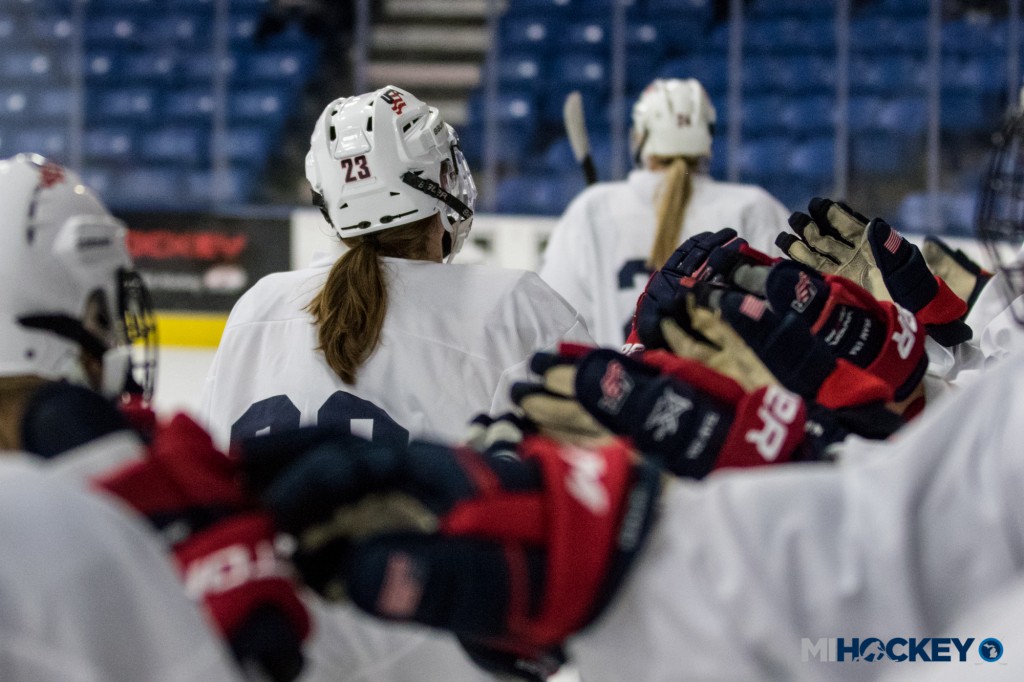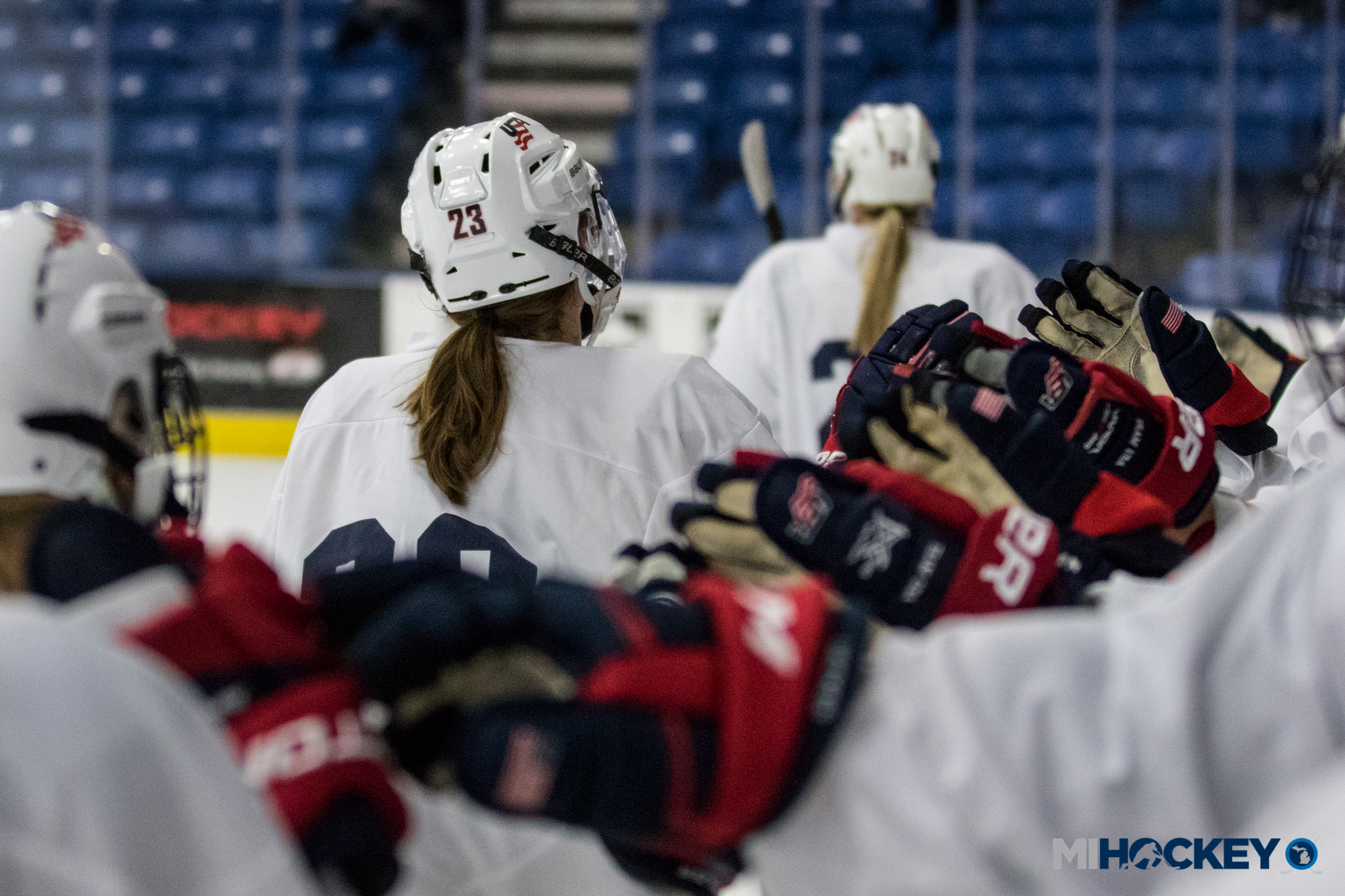USA Hockey makes statement on National Team issues, remains “committed to having the players that were selected” represent USA; women’s team responds

By @MichaelCaples –
USA Hockey issued a new statement/document Friday evening to address many of the issues surrounding the on-going dialogue with the representatives of the U.S. Women’s National Team.
“We remain committed to having the players that were selected to represent the U.S. in the upcoming women’s world championship to be the players that are on the ice when the tournament begins,” said Dave Ogrean, executive director of USA Hockey, in the release.
UPDATE: The Women’s Team has issued a response, which can be seen below. The first paragraph says, “…the players are disheartened by the response, which fails to distinguish between funds from the U.S. Olympic Committee and funds from USA Hockey.”
The original release from USAH says the governing body is contacting the legal team for the players to have further conversations and attempt to resolve the matter.
Full USAH statement is here.
Some highlights:
USA Hockey says it is the national governing body for hockey in the U.S., which means that while it organizes and trains international men’s and women’s teams, its primary focus is on the grassroots hockey programs across the country.
It points out that the U.S. Women’s National Team is not a standing team, meaning “that it is not a full-time team with a full-time commitment.”
USAH says it has increased its level of support during the on-going negotiations, which have spanned several months. Here is its latest offer:
USA Hockey has offered terms to the Women’s National Team players for the Olympic training and performance period that include the opportunity to be provided with more than $90,000 in training stipends and other performance incentives for gold-medal performances in both the upcoming IIHF Women’s World Championship and the Olympic Winter Games. In the case of silver-medal performances in both events, players could receive $74,000 each. USA Hockey’s offer to the players is more than 50% greater than what they received in 2014. These figures do not include other substantial expenditures by USA Hockey for housing stipends, travel allowances, meal expenses, medical and disability insurance and the infrastructure that includes elite level support staff to train and prepare the players.
In non-Olympic years, players are typically together at various times throughout the year for approximately 60-70 days, for two competitions and three to four camps. Most players receive $24,000 each in cash training stipends, allocated by USA Hockey through funding provided by the U.S. Olympic Committee. Players are also eligible for a performance bonus up to $7,500 for winning gold in the world championship. Those funds are in addition to other expenditures for housing, travel, meals, insurance and the infrastructure that includes elite level support staff to train and prepare the players, a total that exceeds $1 million annually.
USAH says based off its calculations, the players’ demands “would result in total player compensation in an Olympic year of approximately $210,000 per player if the team attains a silver medal and $237,00 for a gold medal.”
Here is USAH’s response to the question: “Why will USA Hockey not provide players a living wage?”
Providing players a living wage implies USA Hockey employs players and it does not. Simply, USA Hockey does not pay players a salary – women or men – and instead provides training stipends and support to help put athletes that participate on our national teams in the best possible position to compete for a gold medal. USA Hockey is not a professional sports league, rather a non-profit organization that fields teams for international competition with players who participate on a voluntary basis. In a non-Olympic year, players from the U.S. Women’s National Team are typically involved in official team activities for a period of 60-70 days over the course of a year, while in an Olympic year, players have typically trained together in a residency program for the six months prior to the Games.
USAH concludes the statement spelling out the ways the governing body has worked to grow girls’/women’s hockey. Here they are, straight from the release:
- Walter Bush, longtime president of USA Hockey, was the driving force in getting women’s ice hockey added to the Olympic Winter Games program. The first Olympic Women’s Ice Hockey tournament was held in 1998.
- USA Hockey started the first women’s college hockey national championship in 1998, then tabbed as the American Women’s College Hockey Alliance Division I National Championship. In 2001, the NCAA took over responsibilities of staging the event.
- Through on-going development activity, USA Hockey has grown female participation from just more than 28,000 in 1998 to more than 73,000 today.
- The USA Hockey Foundation created the Patty Kazmaier Memorial Award in 1998 to honor the top NCAA Division I women’s ice hockey player in the country and has presented it every year since.
- USA Hockey was a leading proponent of starting both the IIHF Women’s World Championship (1990) and also the IIHF U18 Women’s World Championship (2008) to further the sport and opportunity for elite player development.
- USA Hockey established a separate women’s section director in its overall operational structure starting with the 1988-89 season to focus specifically on issues pertinent to girls and women’s ice hockey.
- USA Hockey provides opportunities for the top girls from across the country to participate in its summer player development camps. Nearly 500 girls each summer between the ages of 15-18 get the chance for advanced training and development.
- USA Hockey has conducted national championship tournaments for girls and women dating back to 1978.
- Through its own communication channels (website, social media, magazine, newsletters) and through PR efforts with local, regional, national and international media, USA Hockey is regularly engaged in the overall promotion and exposure of girls and women’s hockey.
- USA Hockey is a leader in its support of IIHF Girls’ Hockey Weekend, regularly leading the world in the number of events staged across the country in furthering the advancement and promotion of the sport at the girls level.
UPDATE: Here is the response issued by the Women’s Team through their legal team.
USA Hockey has issued a press release with patently false information about the status of its negotiations with the players of the Women’s National Hockey Team. The players are disheartened by the response, which fails to distinguish between funds from the U.S. Olympic Committee and funds from USA Hockey.
USA Hockey’s financial support for the Women’s National Team has been limited to the six-month period surrounding the Olympics—meaning that in 2014, USA Hockey paid the Women’s Olympic Team $1,000 per month for six months leading up to and including the Olympics, and virtually nothing outside of that time period, despite requirements that the players train on their own time, report to training camps, and compete in the World Championship, Four Nations Cup, and other games during the 42 months between Olympic periods. To say that USA Hockey does not require its elite athletes to train between competitions and that training camps are voluntary is simply untrue. Players who fail to report to training camp are not eligible for selection to the team and USA Hockey coaches contact players between competitions to check on the status of their training programs.
In USA Hockey’s most recent proposal to the players, which came earlier this week, USA Hockey increased its offer to $3,000 per month for six months for a total of $18,000, but again failed to address the non-Olympic period. While USA Hockey focuses on medal incentives to bolster its purported offer to the players, those incentives come from the U.S. Olympic committee, are available to all Olympic athletes across sports, and do not contribute toward USA Hockey’s obligation as a national governing body to grow the sport equitably for boys, girls, men, and women.
Noticeably absent from USA Hockey’s press release is a breakdown of what it has offered the players for its commitment during the 3.5 years out of the Olympic period. The players encourage the public to seek clarity on this issue.

